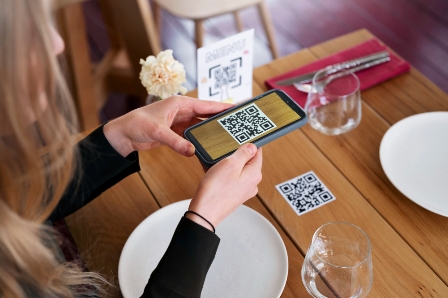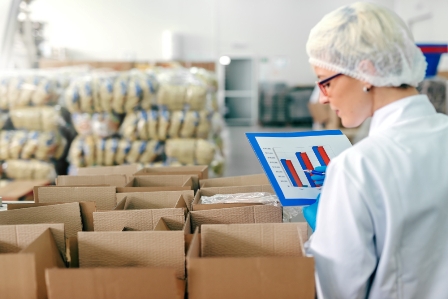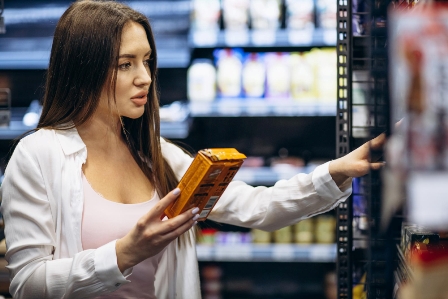Perfumes, known for their enchanting scents, have the power to elevate your mood and enhance your style. However, the world of fragrances is not immune to counterfeit products. In this article, we will explore the significance of a perfume’s authenticity and how barcodes play a vital role in ensuring you get the real deal.
The Significance of a Perfume’s Authenticity
The world of fragrances is a realm of elegance, luxury, and personal expression. But in this universe, authenticity is paramount. Counterfeit perfumes abound, and they not only lack the same captivating scents but can also pose health risks. In this section, we’ll explore the significance of perfume authenticity.
Understanding the Role of a Barcode
The barcode on a perfume bottle isn’t just an ornamental design; it’s a critical tool for verification. This section delves into the role of the barcode and why it is essential for confirming the authenticity of your fragrance.

Scanning Barcodes for Perfume Verification
Scanning a perfume barcode is a straightforward yet highly effective method to determine the authenticity of your fragrance. This process can be done by anyone with access to a barcode scanning app. In this section, we’ll guide you through the steps of scanning a perfume barcode and help you understand the information it provides.
Acquire a Barcode Scanning App
To begin, you’ll need to install a barcode scanning app on your smartphone. There are various free and paid apps available for both Android and iOS devices. Simply go to your device’s app store, search for “barcode scanner,” and choose an app with good reviews and high ratings.
Interpret the Information
The app will instantly provide you with information about the perfume. This typically includes the product name, brand, size, fragrance notes, and sometimes even a link to the official website. It’s important to cross-check this information with the details provided on the perfume’s packaging.
Verify Authenticity
To verify the perfume’s authenticity, compare the information obtained from the app with the packaging details. Look for discrepancies in the product name, brand, fragrance notes, and other essential features. If the information doesn’t match or if the app doesn’t recognize the barcode, it could be an indicator that the perfume is not authentic.
Further Verification
If you still have doubts about the perfume’s authenticity, you can contact the brand’s customer service or visit their official website. They can assist you in confirming whether the barcode corresponds to a genuine product.
Analyzing the Barcode Data
Barcodes, often overlooked, contain a wealth of information about a perfume. Unraveling this data can offer valuable insights into the fragrance, its origins, and more. In this section, we’ll explore how to analyze the information provided by the barcode on a perfume bottle.
Manufacturer or Brand Identification
One of the first pieces of information embedded in a perfume barcode is the manufacturer or brand. This can help you confirm the authenticity of the product. Look for the brand’s name or a unique identifier within the barcode.
Product Type and Name
The barcode often includes details about the product type and name. This can provide you with a quick reference to verify if the fragrance matches the description on the packaging.
Batch or Lot Number
Many barcodes contain a batch or lot number. This number is crucial for quality control and tracking purposes. It can help you determine the production date and ensure you’re getting a fresh product.
Size and Volume
The barcode may also encode information about the size and volume of the perfume bottle. This is particularly important when you’re buying a specific quantity of the fragrance.
Examining Packaging and Labels
Authentic perfumes are a work of art, and their packaging and labels reflect the care and attention to detail put into every bottle. In this section, we’ll guide you on what to look for in the packaging and labels of a perfume to ensure its authenticity.

Holographic Seals and Stamps
Many genuine perfumes feature holographic seals or stamps on the packaging or bottle. These are difficult to counterfeit and serve as a clear indicator of authenticity. When tilting the product, the hologram should change or reveal intricate patterns.
Quality of Materials
Examine the packaging materials closely. Authentic perfumes are often housed in high-quality, sturdy boxes with well-printed labels. Low-quality materials, flimsy boxes, or labels with blurry printing can be a red flag.
Spelling and Grammar
Authentic fragrances pay great attention to detail, and this includes the packaging text. Check for any spelling or grammatical errors on the packaging and labels. Errors in branding or product information are a sign of potential counterfeits.
Brand Logo and Design
The brand’s logo and design should be consistent and high-quality. Counterfeiters may not replicate these elements accurately. Look for variations in font, color, or design that deviate from the official branding.
Authenticity Verification Apps
In an age of advanced technology, verifying the authenticity of your perfume has become more accessible and convenient. Authenticity verification apps have emerged as trusty companions in this endeavor, helping consumers ensure that they’re purchasing genuine fragrances. Here, we’ll introduce you to these valuable tools.
Scent Authenticity Apps
Some apps focus exclusively on verifying the authenticity of a perfume’s scent. They use advanced algorithms to analyze the fragrance’s olfactory profile and compare it to the expected characteristics of the genuine product. If a significant variance is detected, the app may raise a warning.
Barcode Scanning Apps
Barcode scanning apps are indispensable for verifying the authenticity of a perfume. By scanning the barcode on the packaging or bottle, these apps cross-reference the information with the brand’s database to confirm if it matches a legitimate product.
Hologram Detection Apps
Authentic perfumes often feature holographic seals or stamps on their packaging. Hologram detection apps assist in identifying the unique patterns and changes that should occur when tilting the product. They help users distinguish between genuine holograms and counterfeit ones.
Official Brand Apps
Many perfume brands offer their own official apps, which provide detailed product information, including descriptions, batch numbers, and even purchase locations. Using the official app of the brand you’re interested in ensures that you’re getting accurate information.
Fragrance Authenticity
The scent of a perfume is not just a pleasing sensory experience; it can also be a telling indicator of a fragrance’s authenticity. Counterfeit perfumes often fall short in replicating the complex and nuanced aromas found in genuine products. In this section, we’ll discuss how to discern genuine fragrances from counterfeits based on their olfactory characteristics.
Familiarity with the Genuine Scent
One of the most effective ways to detect a counterfeit perfume is by being intimately familiar with the scent of the genuine product. Regularly using or sampling authentic perfumes can help you develop a keen sense of their unique fragrance notes and overall scent profile.
Initial Scent
When you first spray or apply a perfume, pay attention to the initial scent. Genuine fragrances often have a well-balanced and harmonious opening, with notes that blend seamlessly. Counterfeit perfumes may have a harsh, synthetic, or overly intense initial scent.
Evaluating the Scent
Choosing a perfume goes beyond authenticity; the scent is the heart of the matter. Evaluating a fragrance is a personal journey, and it’s essential to ensure that the scent aligns with your preferences.

Ingredient Analysis
The ingredients used in a perfume are like the building blocks of its unique scent. Understanding these ingredients can provide valuable insights into a perfume’s quality and authenticity. In this section, we’ll explore the key components that make up your favorite fragrances.
Allergens and Irritants
Some perfume ingredients, both natural and synthetic, can cause allergies or skin irritation in sensitive individuals. Authentic perfumes typically list potential allergens and irritants on their packaging to ensure consumer safety.
Alcohol Content
The alcohol content in a perfume affects its projection and longevity. High-quality perfumes often use pure, high-proof alcohol to ensure the scent is carried effectively without interference from other odors.
Self Life
A perfume’s shelf life can affect its scent and authenticity. We’ll explain how to determine if a perfume is still in its prime or past its expiration date.
Pricing
Pricing can be an indicator of authenticity. We’ll discuss how to navigate the world of perfume prices and avoid deals that seem too good to be true.
Purchase from Reputable Sources
One of the most reliable ways to ensure you’re buying an authentic and high-quality perfume is to purchase it from reputable sources. The source from which you buy a perfume plays a pivotal role in determining its authenticity and overall quality. Here’s how to identify and choose trustworthy outlets for your fragrance purchases:

Authorized Retailers:
Opt for authorized retailers and official brand stores. Perfume brands often list their authorized retailers on their websites. Buying from these sources reduces the risk of encountering counterfeit or subpar products.
Boutique Perfume Stores:
Specialized fragrance boutiques and perfumeries tend to carry genuine and carefully curated selections of perfumes. The staff in these stores are often knowledgeable about the products they sell and can provide valuable guidance.
Department Stores:
Well-established department stores frequently carry a wide range of reputable perfume brands. These stores have a reputation to uphold, making them reliable sources for authentic fragrances.
Online Retailers:
When purchasing perfume online, stick to well-known and trusted e-commerce platforms. Amazon, Sephora, and official brand websites are examples of reputable online sources. Look for customer reviews and ratings to gauge the authenticity of products.
FAQs
Here are answers to some frequently asked questions about Codigo de Barras Perfume
The barcode on perfume is a unique combination of lines and numbers that serve as an identification code for the product. It contains information about the manufacturer, product type, and other essential details. Scanning this barcode can help verify the authenticity of the perfume.
Perfume doesn’t expire in the same way food does, but it can degrade over time. The scent of a perfume can change due to exposure to light, temperature fluctuations, and oxygen. Proper storage can extend a perfume’s shelf life. On average, most perfumes maintain their quality for 3 to 5 years.
Even unopened perfumes can deteriorate over time, although they tend to have a longer shelf life than opened ones. Proper storage—away from direct sunlight, extreme temperatures, and tightly sealed—can help unopened perfumes last longer.
A 10-year-old perfume may still be good, but its scent might have changed or weakened over time. The longevity of a perfume depends on the specific ingredients, storage conditions, and the brand. It’s best to give it a sniff to see if it’s still to your liking.
Perfume can last for 20 years or more if stored correctly. However, its scent may have evolved or become weaker during this time. Whether it’s still good after two decades largely depends on the storage conditions and the specific perfume.
Perfume doesn’t necessarily go bad after 10 years, but it might not smell the same as when it was first bottled. The scent can change, weaken, or lose some of its complexity over time. To determine if a perfume is still good after a decade, it’s advisable to test it to see if it meets your olfactory preferences.
Conclusion
In the captivating world of perfume, barcodes may seem like small details, but they play a significant role in ensuring quality, authenticity, and efficient supply chain management. As technology continues to advance, the role of barcodes in the perfume industry is poised to evolve even further.





